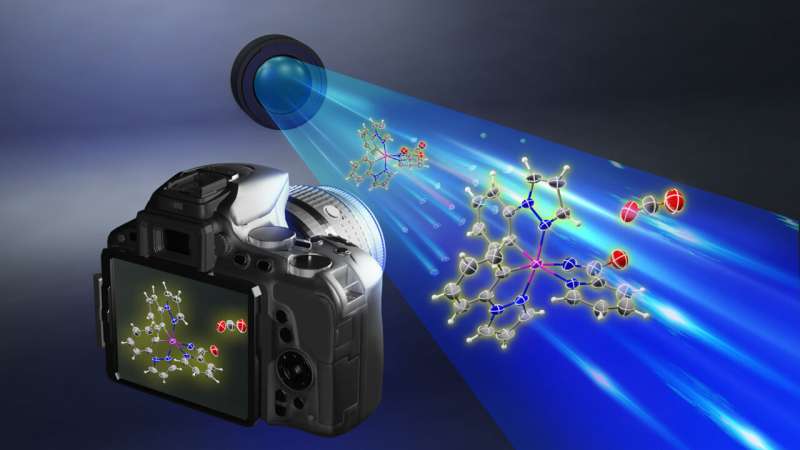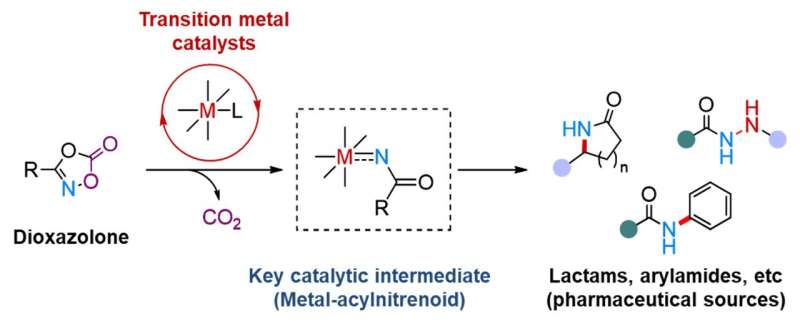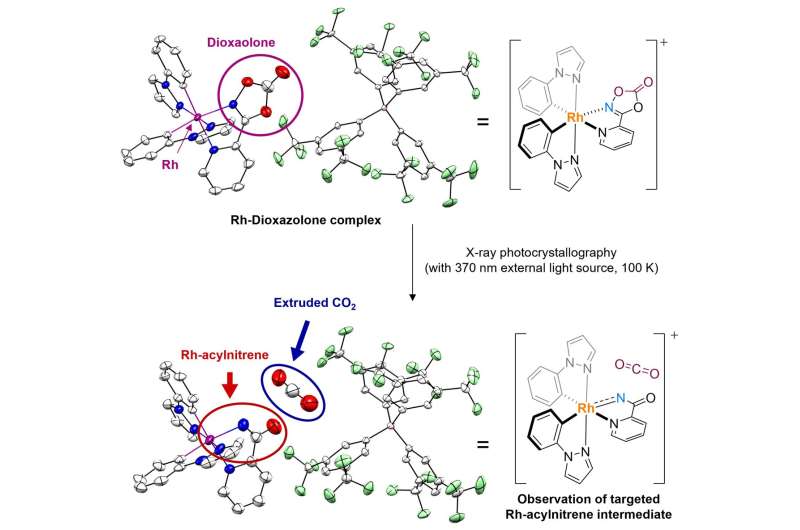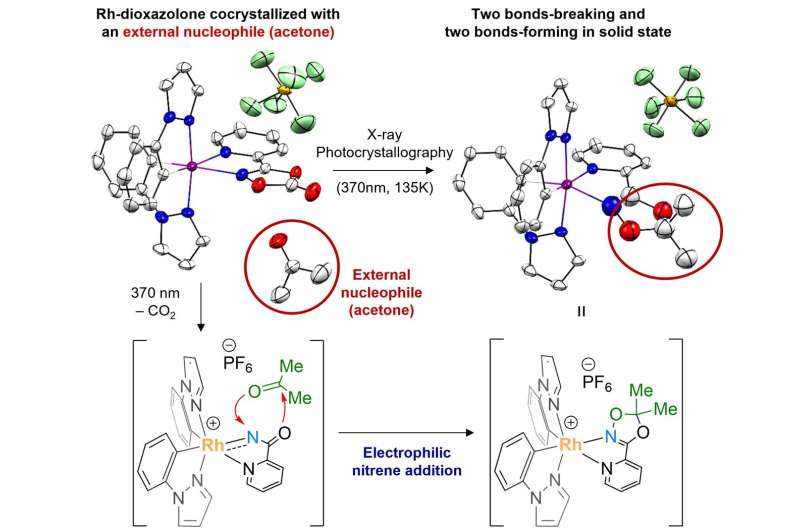This article has been reviewed according to Science X's editorial process and policies. Editors have highlighted the following attributes while ensuring the content's credibility:
fact-checked
peer-reviewed publication
trusted source
proofread
Observing the long-postulated intermediate of catalytic amination reactions

Researchers at the Institute for Basic Science (IBS) in South Korea have made a groundbreaking discovery by identifying the structure and reactivity of rhodium-acylnitrenoid intermediates in catalytic hydrocarbon amination reactions. By studying rhodium-dioxazolone coordination complex using photoinduced single crystal X-ray diffraction analysis, they captured the fleeting moment of Rh-acylnitrenoid intermediate formation.
The findings are published in the journal Science.
This achievement is expected to pave the way for developing highly reactive and selective catalysts for converting hydrocarbons into value-added products, with potentially wide-ranging applications in various industries.
Led by Director Chang Sukbok, scientists from the Center for Catalytic Hydrocarbon Functionalizations within the Institute for Basic Science (IBS) have made a breakthrough in understanding the structure and reactivity of a key intermediate in catalytic reactions. This intermediate, known as a transition metal-nitrenoid, plays a crucial role in converting hydrocarbons into amides, which are important in pharmaceuticals and materials science.
In chemical reactions, intermediates are substances that are formed and consumed during the transformation of reactants into products. Hence, understanding these intermediates is crucial for improving reaction pathways and developing efficient catalysts. For example, nitrogen-containing compounds form the backbone of approximately 90% of pharmaceuticals and are essential in materials science.
Therefore, identifying the intermediates involved in amination reactions, where nitrogen-based functional groups are introduced into hydrocarbon raw materials, is highly important.

Researchers recognized the importance of understanding the structure and properties of reaction intermediates in amination reactions. In particular, the reactions that utilize transition metal catalysts and dioxazolone reagents were found to be highly useful for medicinal chemistry and materials science, with more than 120 research groups worldwide contributing to the development of this field.
The key to understanding these reactions at the fundamental level lay in the ability to study the reaction intermediate that forms when a transition-metal catalyst binds to the dioxazolone reagent—known as metal-acylnitrenoid. These intermediate species have been notoriously difficult to study due to their highly reactive nature, which only allows them to exist for a fleeting moment.
In addition, traditional catalytic reactions often occur in a solution, where the intermediary substances quickly react with other molecules, making them even more difficult to study.
To tackle this challenge, the IBS team devised an experimental approach using X-ray photocrystallography. In addition, they also focused on tracking chemical reactions in solid-state rather than in liquid solutions. For this purpose they developed a new chromophoric rhodium complex with a bidentate dioxazolone ligand, where photoinduced metal-to-ligand charge transfer initiates catalytic C–H amidation of hydrocarbon sources such as benzene.

Using this newly designed system, the researchers synthesized an isolable rhodium-dioxazolone coordination complex. Then, through photoinduced single crystal X-ray diffraction analysis using synchrotron radiation (Pohang Accelerator Laboratory), they managed to reveal the structure and properties of the rhodium-acylnitrenoid intermediate for the first time.
Moreover, this study was designed to also achieve crystallographic monitoring of rhodium-acylnitrene transfer toward an external nucleophile all in the solid phase, which provides complete mechanistic snapshots of the nitrenoid transfer process.
This research marks a significant step forward compared to previous research in the field of catalysis involving metal-nitrenoid intermediates. By observing metal-nitrenoid intermediates in catalytic reactions and the study provides crucial insights into their reactivity. These findings are expected to contribute to the development of more reactive and selective catalysts for hydrocarbon amination reactions in the future.

Director Chang highlighted the importance of this discovery by stating, "We have experimentally captured the transition metal-nitrenoid intermediate, whose existence had only been hypothesized and was difficult to prove." He further noted that this research would provide important clues for the design of highly reactive and selective catalysts that could be useful across various industries, possibly even contributing to the development of a "universal catalyst."
More information: Hoimin Jung et al, Mechanistic snapshots of rhodium-catalyzed acylnitrene transfer reactions, Science (2023). DOI: 10.1126/science.adh8753. www.science.org/doi/10.1126/science.adh8753
Journal information: Science
Provided by Institute for Basic Science



















